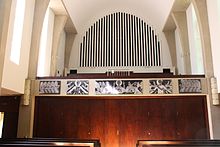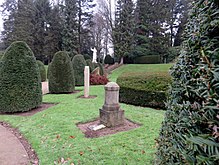Anita Rée

Anita Clara Rée ( February 9, 1885 , Hamburg - December 12, 1933 , Kampen on Sylt ) was a German avant-garde painter who worked during the Weimar Republic .
life and work
Anita Rée was the second daughter of the businessman Israel Rée and his wife Clara, nee. Rooster. The Hamburg line of the long-established Jewish merchant family traded mainly in grain and East Indian goods for generations. Anita and her sister Emilie were baptized and confirmed Evangelical Lutheran. The Protestant upbringing in the assimilated parental home was followed by the appropriate education as a “higher daughter”. The older sister Emilie (* 1883) married the lawyer Heinrich Friedrich Welti (* 1881) from Bremen, who came from a Swiss family.
artistic education
From 1905 Anita Rée took painting lessons with the Hamburg artist Arthur Siebelist . Since she was plagued by self-doubt about her career aspiration, she sought advice from Max Liebermann in Berlin in 1906 . He recognized Rées talent and advised her to continue her training as a painter. Since there was no regular academy training for women in the arts in the Hanseatic city, Rée trained at Siebelist until 1910 and then formed a studio community with Franz Nölken and Friedrich Ahlers-Hestermann . The friendship broke up due to Rée's unrequited love for Nölken.
In winter 1912/1913 Rée was in Paris and learned there within Fernand Léger the figure drawing . Influences from Picasso , Matisse and Cézanne can also be seen in their work.
Artistic breakthrough
In 1913, Rée took part in an exhibition at the Commeter Gallery in Hamburg. In 1914 she made the acquaintance of the poet Richard Dehmel . In the following years she gained recognition for her portraits. In 1919 Rée was a founding member of the Hamburg Secession Artists' Association and received great attention in the following exhibitions. She met with artists such as Gretchen Wohlwill , Alma del Banco and Franz Radziwill . In 1920 she joined the Hamburg Art Association . In 1921 she made a trip to Pians in Tyrol. From 1922 to 1925 Rée lived mainly in Positano on the Italian Amalfi Coast, where he turned to the New Objectivity . During this time she was friends with the bookseller and painter Christian Selle. She only returned to Hamburg for exhibitions. From 1926 Rée lived again in Hamburg and in the same year was co-founder of the GEDOK (Association of German and Austrian Artists' Associations of All Art Genres), which still exists today . Anchored in Hamburg society, not only her portraits found their way into the corresponding families in the area. The most extensive collection of her pictures was built up by the patron Valerie Alport , who donated a large part to the Jewish Museum Berlin in the course of her emigration in 1937 .
In 1929 and 1931, she executed larger murals in two schools newly built by the Hamburg architect and urban planner Fritz Schumacher , for which Rée received great praise. The mural in the Uferstrasse vocational school, The Wise and Foolish Virgins , was destroyed by the National Socialists . Only the mural Orpheus with the animals in the gymnastics room of the former secondary school for girls on Caspar-Voght-Straße (OCV) - merged with the Kirchenpauer-Gymnasium from 1982 to summer 1986 - in Hamburg-Hamm remained, but was painted over. In 1954 it was roughly restored and around 1969 it disappeared behind wooden cladding to protect it from ball throwing. It can currently be seen in the Fokine Studio of the Hamburg Ballet School , after it was restored during the renovation work from a grammar school to a ballet school in the late 1980s. Like the building at Caspar-Voght-Straße 54, the mural is a listed building .
Ostracism and death
In 1930, Rée received an order to create a triptych for the altar of the new Ansgar Church in Hamburg-Langenhorn . The Passion themes consisted of the entry into Jerusalem, the Lord's Supper, the arrest in Gethsemane, and the parable of the wise and the foolish virgins. The community was not satisfied with Rées designs, in 1932 the order was withdrawn due to "cultic concerns". In 1930, Rée was denounced as a Jew by the NSDAP in this context . The pictures were never on the altar of the church, were probably stored in the main church of St. Nikolai and burned when the church was destroyed in the nights of bombing in 1943. Black and white photographs of the design have been on view in the organ loft of the Ansgar church for many years.
In 1932 Rée left Hamburg and moved to Sylt . On April 25, 1933, she was defamed and excluded by the Hamburg artists as a "foreign member". For a long time the artist had been lonely by hostility and personal disappointments; all of this drove her to suicide on December 12, 1933 . Shortly before she committed suicide, she wrote to her sister Emilie:
- “I can no longer find my way in a world like this and I have no other wish than to leave it, which I no longer belong to. What is the point - without family and without the once beloved art and without any people - to continue to vegetate lonely in such an indescribable, maddened world ...? "
Paintings (selection)
Portrait of Dr. Malte Wagner , 1920, private collection
Portrait of Carl Einstein , before 1921, private property
Portrait of Hildegard Heise , 1928, private property
Collection in the Hamburger Kunsthalle
Seven paintings by Anita Rées, which Gustav Pauli had acquired for the Hamburger Kunsthalle in the 1920s , were to be removed from the collection in 1937 as " degenerate art ". The then caretaker of the Kunsthalle, Wilhelm Werner , hid these works - among others - in his apartment, thereby saving them for posterity. After 1945 he tacitly returned them to the Kunsthalle's inventory. An exhibition at the Kunsthalle in 2011/12 was dedicated to the caretaker and his collection.
The Hamburger Kunsthalle showed the first retrospective of Rées work in 2017/2018 . In this context, in 2018 she was the editor of a comprehensive catalog raisonné, compiled by Maike Bruhns and published by Prestel Verlag . Building on the first catalog raisonné from 1986, the publication presents new research results and rediscovered main works by the artist.
Memorial sites


On August 7, 2007, in memory of the ostracized painter, a stumbling block was laid at Wattweg 10 in Kampen on Sylt. Another stumbling block at 11 Fontenay Street points to Rée's last place of residence in Hamburg.
After the urn cemetery at the Old Crematorium on Alsterdorfer Strasse was closed, Anita Rée's urn found a new, dignified place in the Hamburg cemetery in Ohlsdorf in the area of the Althamburg Memorial Cemetery .
Anita-Rée-Strasse in Hamburg-Neuallermöhe was named after her in 1984.
Exhibitions (selection)
- 1986: Eva and the future. The image of women since the French Revolution , Hamburger Kunsthalle
- 2001: Anita Rée in the Valerie Alport Collection , Gallery 1, Hamburg.
- 2004: Art of the 1920s in Hamburg , Hamburger Kunsthalle
- 2005: Excluded , Hamburger Kunsthalle
- 2006: Avant-garde artists , Hamburger Kunsthalle
- 2010: heaven on time. Art of the 1920s in Hamburg , Hamburger Kunsthalle
- 2011/2012: The collection of the caretaker Wilhelm Werner , Hamburger Kunsthalle
- 2015/2016: empathy and abstraction. The modern age of women in Germany , Kunsthalle Bielefeld .
- 2016/2017/2018: stubbornness. GEDOK artists in the Hamburg Secession, Museum of Arts and Crafts Hamburg , October 21, 2016 to February 4, 2018
- 2017/2018: Anita Rée - Retrospective , Hamburger Kunsthalle , October 6, 2017 to February 4, 2018
auction
The 90 × 70.5 cm oil painting The Blue Woman from 1919, which depicts a mother dressed completely in blue with two children in front of cubist architecture, was sold on December 7, 2019 at the Ketterer Munich auction house at an estimate of € 40,000 - € 60,000 after a Bidding battle for a total of € 875,000.
literature
- Carl Georg Heise : Anita Rée. Christians, Hamburg 1968.
- Bettina Roggmann: Anita Rée. In: Eva and the future. Prestel, Munich 1986. (Exhibition catalog Hamburger Kunsthalle)
- Jutta Dick, Marina Sassenberg (ed.): Jewish women in the 19th and 20th centuries. Rowohlt, Reinbek 1993, ISBN 3-499-16344-6 .
- Maike Bruhns : Anita Rée. Life and work of a Hamburg painter 1885–1933. Association for Hamburg History, Hamburg 2001, ISBN 3-923356-15-3 .
- Maike Bruhns: Jewish Art? Anita Rée and the New Objectivity. In: Hamburg Key Documents on German-Jewish History, December 6, 2016. doi : 10.23691 / jgo: article-106.de.v1
- Annegret Erhard: Anita Rée. Ahead of the times. A Hamburg artist of the 1920s. Edition Braus, Berlin 2013, ISBN 978-386228-071-1 .
- Rée, Anita . In: Franklin Kopitzsch, Dirk Brietzke (Hrsg.): Hamburgische Biographie . tape 3 . Wallstein, Göttingen 2006, ISBN 3-8353-0081-4 , p. 307-309 .
- Fritz Schumacher : 24 murals in Hamburg state buildings , Broschek, Hamburg 1932.
- Karin Schick: Anita Rée: Retrospective. Prestel, Munich 2017, ISBN 978-3-7913-5710-2 . (Exhibition catalog Hamburger Kunsthalle)
- Maike Bruhns: Anita Rée (1885–1933) - Das Werk , in collaboration with Karin Schick and Sophia Colditz, Hamburger Kunsthalle (ed.), Prestel Verlag, Munich 2018, ISBN 978-3-7913-5712-6 .
Web links
- Literature by and about Anita Rée in the catalog of the German National Library
- Literature by and about Anita Rée in the library of the Jewish Museum Berlin
- Anita Rée. In: FemBio. Women's biography research (with references and citations).
- Anita Rée on kunstaspekte.de
- Biography and portrait of Anita Rée at the women's garden
Individual evidence
- ^ Dick / Sassenberg: Jewish women in the 19th and 20th centuries . P. 308.
- ↑ a b Helge Martens: The altarpieces of Anita Rée in the Ansgar Church. Ev.-Luth. Ansgar Congregation, accessed January 27, 2014 .
- ↑ Maike Bruhns: Anita Rée. Life and work of a Hamburg painter 1885–1933, p. 9
- ↑ "[...] She [Rée] was an apprentice at Léger, it is often rumored. But even the research of the exhibition organizers [meaning the exhibition 2017/2018 Kunsthalle Hamburg] did not find any document that could prove this. [...] “Petra Bosetti: Against all odds. [...] The Hamburg painter Anita Rée [...]. In: art das kunstmagazin , October 2017, pp. 44 - 51; P. 47
- ^ A b Adriane von Hoop: Anita Rée. fembio.org, accessed April 30, 2009 .
- ^ A b Egbert A. Hoffmann: Hamburg art behind boards. Hamburger Abendblatt, March 27, 1984.
- ↑ List of monuments ( Memento of June 27, 2011 in the Internet Archive ) (PDF; 915 kB), www.hamburg.de, accessed on September 21, 2011.
- ↑ White trees in Positano , juedische-geschichte-online.net
- ↑ Katja Engler: Late honor for a silent hero. On the occasion of the exhibition of the Wilhelm Werner Collection from September 18, 2011 to January 15, 2012 in the Hamburger aisle of the Kunsthalle. In: Welt am Sonntag , September 4, 2011, accessed on September 5, 2011.
- ↑ Reading sample
- ↑ Anita Rée , frederiks.de, accessed on January 21, 2018
- ↑ Anita-Rée-Straße on bergedorf-chronik.de
- ↑ Empathy and abstraction. The Modern Age of Women in Germany , Kunsthalle Bielefeld, October 30, 2015 to February 28, 2016, accessed on May 8, 2016
- ↑ https://www.kettererkunst.de/result.php accessed on January 10, 2020
| personal data | |
|---|---|
| SURNAME | Rée, Anita |
| ALTERNATIVE NAMES | Rée, Anita Clara |
| BRIEF DESCRIPTION | German painter |
| DATE OF BIRTH | February 9, 1885 |
| PLACE OF BIRTH | Hamburg |
| DATE OF DEATH | December 12, 1933 |
| Place of death | Kampen (Sylt) |


















